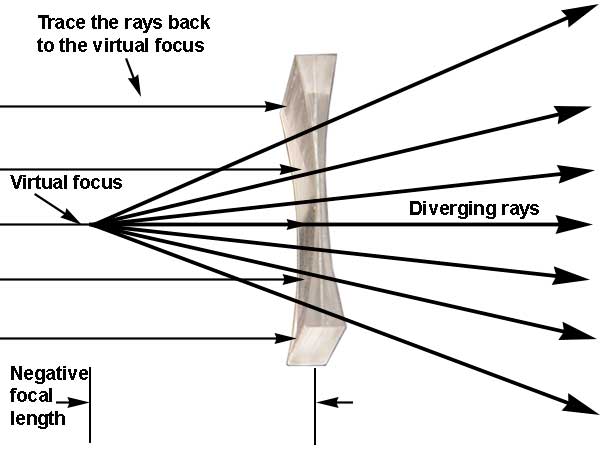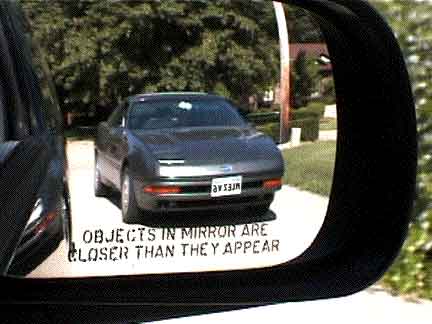When a number of rays starting from a point after suffering reflection or refraction converge to meet or appear to meet(diverge from) a second point, then this second point is called the Image of the first point.


Image formed is of two types:
Real image
Virtual image
Real image :
If the rays of light starting from a point after suffering reflection or refraction actually meet at the second point, then the image formed will be real as shown in fig.1. Real image can be taken on screen.
Virtual image :
If the rays starting from a point after suffering reflection or refraction do
not actually meet but appear to diverge from a second point, then this type of image formed is virtual in nature. e.g., when we look our face in a plane mirror, we see an virtual image of our face in the plane mirror. A virtual image is shown in fig.2.
Image formation in Spherical Mirrors:
Let us first discuss the rules for forming image of an extended object by a spherical mirror. while drawing a ray diagram for the formation of an image of an object, remember to keep this in mind:
(a) A ray parallel to principal axis after suffering reflection from-
(i) a concave mirror will pass through principal focus.
(ii) a convex mirror will appear to diverge (coming out) from the principal focus.
(b) A ray passing through the centre of curvature of mirror (concave as well as convex mirrors) will retrace its path after suffering reflection from mirror.
(c) A ray passing through the principal focus of-
(i) Concave mirror the ray of light will be reflected, and will became parallel to principal axis.
(ii) Convex mirror the ray of light appearing to be diverging out of principal focus of the convex mirror will be reflected and will become parallel to principal axis of mirror.
(d) A ray of light falling on the pole of mirror (convex or concave) at some angle to the principal axis, is reflected by making same angle (as angle of incidence) with the principal axis.
Applications of Spherical Mirrors :
Spherical mirrors have the following important applications :
(a) Concave mirrors :
(1) They are used in search lights, head lights for vehicles, torches etc.
(2) These are used as paraboloids in dishes for receiving and sending radio signals.
(3) They are used as reflectors in cinema projectors, solar cookers and reflecting type telescopes.
(4) They are used by dentists.
(5) Concave reflectors are used in table lamps.
(6) They are preferred to a plane mirror for shaving because a concave mirror forms an erect, virtual and magnified image when placed close to the eye.

(b) Convex mirrors :
(1) It is used as rear view mirror in vehicles i.e., for looking at the back traffic because a convex mirror always forms erect and diminished image of the traffic behind the automobile. It helps driver to get a wide view of the traffic coming from behind.
(2) Some camera phones use convex mirrors to allow the user correctly aim the camera while taking self portrait.
(3) It can also be used as a reflector for street lighting purpose.

Courtesy:demoweb.physics.
sharvaree.blogspot.com
http://www.ux1.eiu.edu


Image formed is of two types:
Real image
Virtual image
Real image :
If the rays of light starting from a point after suffering reflection or refraction actually meet at the second point, then the image formed will be real as shown in fig.1. Real image can be taken on screen.
Virtual image :
If the rays starting from a point after suffering reflection or refraction do
not actually meet but appear to diverge from a second point, then this type of image formed is virtual in nature. e.g., when we look our face in a plane mirror, we see an virtual image of our face in the plane mirror. A virtual image is shown in fig.2.
Image formation in Spherical Mirrors:
Let us first discuss the rules for forming image of an extended object by a spherical mirror. while drawing a ray diagram for the formation of an image of an object, remember to keep this in mind:
(a) A ray parallel to principal axis after suffering reflection from-
(i) a concave mirror will pass through principal focus.
(ii) a convex mirror will appear to diverge (coming out) from the principal focus.
(b) A ray passing through the centre of curvature of mirror (concave as well as convex mirrors) will retrace its path after suffering reflection from mirror.
(c) A ray passing through the principal focus of-
(i) Concave mirror the ray of light will be reflected, and will became parallel to principal axis.
(ii) Convex mirror the ray of light appearing to be diverging out of principal focus of the convex mirror will be reflected and will become parallel to principal axis of mirror.
(d) A ray of light falling on the pole of mirror (convex or concave) at some angle to the principal axis, is reflected by making same angle (as angle of incidence) with the principal axis.
Applications of Spherical Mirrors :
Spherical mirrors have the following important applications :
(a) Concave mirrors :
(1) They are used in search lights, head lights for vehicles, torches etc.
(2) These are used as paraboloids in dishes for receiving and sending radio signals.
(3) They are used as reflectors in cinema projectors, solar cookers and reflecting type telescopes.
(4) They are used by dentists.
(5) Concave reflectors are used in table lamps.
(6) They are preferred to a plane mirror for shaving because a concave mirror forms an erect, virtual and magnified image when placed close to the eye.

(b) Convex mirrors :
(1) It is used as rear view mirror in vehicles i.e., for looking at the back traffic because a convex mirror always forms erect and diminished image of the traffic behind the automobile. It helps driver to get a wide view of the traffic coming from behind.
(2) Some camera phones use convex mirrors to allow the user correctly aim the camera while taking self portrait.
(3) It can also be used as a reflector for street lighting purpose.

Courtesy:demoweb.physics.
sharvaree.blogspot.com
http://www.ux1.eiu.edu
Amazing........
ReplyDeleteDifference between real and virtual image
ReplyDelete
ReplyDeleteReally i like the way of your blog post content, it's a good information..
is jeep wrangler good for camping
jeep wrangler camping accessories